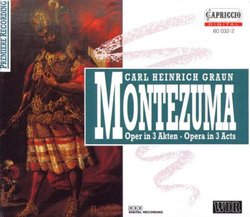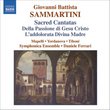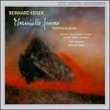| All Artists: Carl Heinrich Graun, Johannes Goritzki, Encarnacion Vazquez Title: Graun - Montezuma / Goritzki Members Wishing: 0 Total Copies: 0 Label: Capriccio Release Date: 4/8/2008 Album Type: Import Genre: Classical Styles: Opera & Classical Vocal, Historical Periods, Classical (c.1770-1830) Number of Discs: 2 SwapaCD Credits: 2 |
Search - Carl Heinrich Graun, Johannes Goritzki, Encarnacion Vazquez :: Graun - Montezuma / Goritzki
 | Carl Heinrich Graun, Johannes Goritzki, Encarnacion Vazquez Graun - Montezuma / Goritzki Genre: Classical
|
Larger Image |
CD DetailsSimilar CDs |
CD ReviewsMontezuma: a forgotten 18th century german baroque opera J. E. ASENCIO-NEGRON | Guaynabo, Puerto Rico USA | 05/07/2000 (4 out of 5 stars) "It is well known that Frederick II "The Great" of Prussia was an accomplished flautist and composer. Frederick's beliefs were humanist rather than Christian and this influenced his choice of libretto for the opera MONTEZUMA (Berlin, 1755), with music by Carl Heinrich Graun (1704-59). The text, by Frederick himself is written from the point of view of the king Montezuma II (1502-1520), last ruler of the Aztecs, who was sacrified to the greed and cruelty of the conquistadores' (spaniards) barbarous ways when he allowed them into his imperial realm (México) following the mythical prophecies of the aztec people (Fernando Cortes was confused as the return of Quetzalcoatl, toltec divine king). Graun's oratorio DER TOD JESU (1755), which was as successful as Handel's Messiah in it's time and for many years performed annually in Germany, has been recorded on CD. Der Tod Jesu is thought to be unusual in that it was composed with no interference from Frederick II.There have been some limited revivals of operas from this period (18th century Germany) during the 1990's, one opera by Graun, out of the 27 he composed, was broadcast by Radio 3 in 1996. The appointments of C. H. Graun as royal "kapellmeister" since 1740 & director of the opera at Berlin since 1742, allow him to display his Italianate operas with a polyphonically saturated style, and those of Johann Hasse. Both where the chief representatives of the italian opera in Germany in the 18th century. MONTEZUMA (1755, Berlin), is a baroque opera, thus we see that Graun's arias display coloraturas prominently. I enjoyed Eupaforice's aria "Non àn calma"(I cannot find peace)(CD1, Track 18), in which the Montezuma's fiancee asks the Gods to let her die instead of her lover Montezuma (Dorothea Wirtz (soprano) singing is dramatic, and her control of coloratura allows her to be very effective in this role); also I liked Montezumas' aria "Si, corona I tuoi trofei" (Come and crown your trophies), in which he say to the Cortes and his people that one day they will pay-dearly for their bloody crimes before he is dragged by a detachment of Spaniards to the execution (Ms. Encarnación Vázquez (mezzo-soprano ) is very effective in her fine display of coloratura, although her control of low notes needs more emphasis on her chest voice).The choruses are carefully worked out with attention to the impact they will cause in the audience. I enjoyed 2nd act chorus: "Venite intrepidi stranieri eroi" (Welcome intepid heroes from abroad)(CD1, Track 21), and 3rd act chorus: "Oh Cielo! Ahi giorno orribile" (Oh heaven! Alas what horrible day)(CD 2,Track 24), which is sung by the people of Mexico who takes to flight horrified and confused after the burning/killing caused by the Spaniards." A Monument to Mediocrity Harpsichord Fan | 06/27/2001 (2 out of 5 stars) "The line is very thin and very vague between a work of distinction and a work of mediocrity. An opera of distinction usually has arias and melodies that we as listeners tend to remember and repeat over and over in our heads and to each other. We arrange them, we play them, we love them, like the "Largo" (Ombra mai fu) from Handel's Serse, or the "Brindisi" from Verdi's La Traviata, or especially "L'amour est un oiseau rebel" from Bizet's Carmen. Operas of distinction normally have memorable and fascinating stories, strong character development, and show an effort to truly translate and interpret human emotion in in all its extremities and stylized aspects. Carl Heinrich Graun's 1755 opera Montezuma, written for the opening of the Berlin Opera on Unter der Linden, has no such qualities. Combining perhaps the most facile and fluffy aspects of Roccoco with the worst extremes of stylized and static Baroque opera, Montezuma is thoroughly boring and does not hold much distinction as a work. Orchestration is syrupy and the singing, although showing extensive training, is essentially restrained and bogged down, so to speak, by the music. For some reason, the opera was written for all high voices (much like J.A. Hasse's Cleofide, an opera that, which although superior in all respects, gets somewhat confusing in terms of voice recognition after a while), and instead of using countertenors in addition to female singers the producers have decided to opt for an all-female singing cast. .... The singers in Montezuma have very female timbres and therefore misinterpret the male roles. The sole exception to this fact is the singer who plays Fernando (sic) Cortes, the Spanish conquistador. The Deutsche Kammerakademie Neuss plays with a pleasant professionalism and polish, but Johannes Goritzki's conducting does not seem to find anything particularly significant or earth-shaking in the music. Of course, that may not be his fault. The textual subjects of the arias tend to focus on the two extremes of stylized human emotion: love/bliss and hate/anger. However, Graun's music does not seem to display any recognition of the variety in emotion. Everything sounds the same, whether it be a cavatina sung by an anxious bride or an aria sung by a fierce conqueror who has just mercilessly killed thousands. The same orchestration, the same unremarkable melodies, the same tempi and nuances - they all seem to apply. One falls under the impression that Graun did not even understand the Italian text, or perhaps one had set the libretto to the music long after the latter was written. Which brings me to the subject of the text itself. Originally in French prose, the scenario and libretto were written by Frederick the Great of Prussia himself, and were then set in Italian verse by the court poet Tagliazucchi. Both the scenario and the verse are quite poorly concieved; notable shortcomings include the contrived poetic language, the total lack of any character development, and the addition of a rather ordinary and bloodless romance between Montezuma and the made-up character of "Eupaforice." Overall, the whole work is rather facile and mundane. However, one must also consider that Montezuma represents a crucial piece of operatic history, a transition period of sorts in which composers were moving award from the turgidity of the High Baroque style and more into the Empfindsamer stil, the precursor of what was to become the celebrated Classical Age, the age of Haydn and Mozart." Early Berlin opera Harpsichord Fan | 06/15/1999 (3 out of 5 stars) "Like the better known Adolf Hasse, Carl Heinrich Graun (1704-59) was stylistically one of the post-Bach generation, who is only now being slowly rediscovered. The biggest impetus to this has been Rene Jacobs recording of his opera Cleopatra e Cesare on the Harmonia Mundi label (with a well documented single highlights disc on the HMT label).Montezuma is (as you'd guess) an opera written about Aztecs, which were obviously considered quite exotic in 18th Century Berlin. Preceding broadly the lines followed later Jacob's approach to Graun the conductor here, Johannes Goritzki, rather than employ countertenors has the castrati parts sung by Spanish sopranos (Vazquez, Wirtz, Julian, Ambriz, Sanchez, Tamez, Caridad). As with the Christie recording of Hasse's Cleofide all those sopranos can get a bit wearing at times, but then I suppose the same would be true of all castrati.Other releases from Capriccio in this 2 CDs for the price of 1 series include Hasse's Piramo e Tisbe and Gluck's Orfeo."
|

 Track Listings (27) - Disc #1
Track Listings (27) - Disc #1



